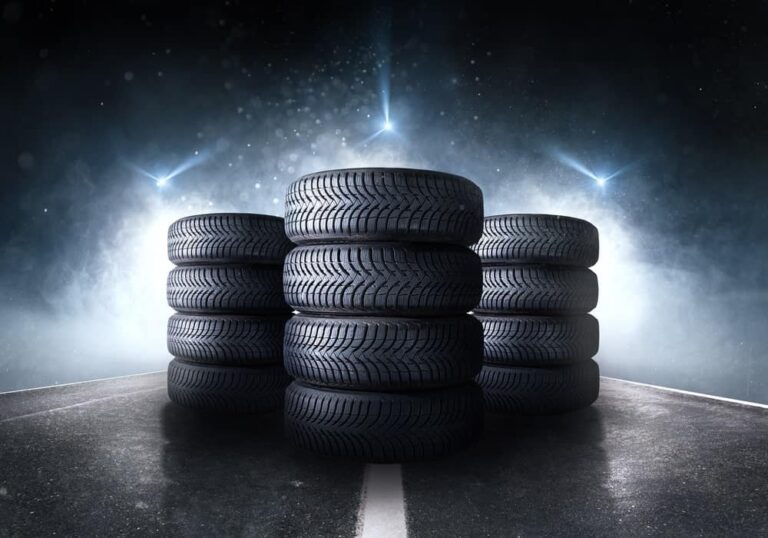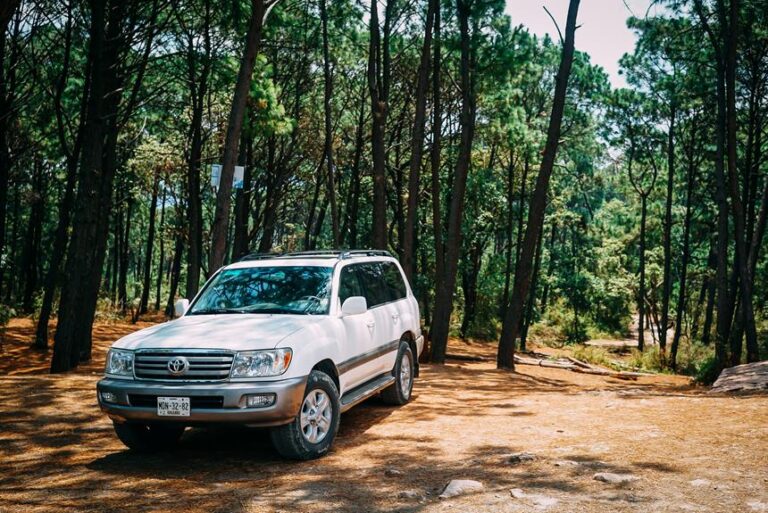All-Terrain Tires Vs. Mud Tires: Which Is Better
In the realm of off-road driving, the choice between all-terrain tires and mud tires can be as crucial as selecting the right gear for an adventurer scaling a treacherous mountain.
Like a compass guiding a trailblazer through uncharted territory, this article aims to provide an objective and informative comparison of these two tire types.
By delving into factors such as traction, durability, handling, and more, we seek to assist those who desire the freedom to conquer any terrain with confidence and ease.
Key Takeaways
- All-terrain tires provide a balance between on-road and off-road performance, while mud tires are specifically designed for off-road use in muddy and rocky terrains.
- All-terrain tires have a tread pattern that allows for good traction on various surfaces, including sand and gravel, while mud tires have a more aggressive tread pattern with larger, deeper lugs that provide superior traction in muddy conditions.
- All-terrain tires offer versatility in different terrains, from muddy trails to sandy beaches, while mud tires excel in muddy and off-road environments.
- All-terrain tires are generally more durable and cost-effective in the long run, while mud tires have deeper treads but wear out faster on regular roads.
Traction and Performance on Different Surfaces
The compound noun 'surface compatibility' plays a crucial role in determining the overall traction and performance of tires on different surfaces. When it comes to all-terrain tires and mud tires, their performance on specific surfaces can vary greatly. Traction on sand and performance on gravel are two important factors to consider.
All-terrain tires are designed to provide a balance between on-road and off-road performance. They feature a tread pattern that allows for good traction on various surfaces, including sand and gravel. The tread blocks are designed to provide grip and stability, allowing the tires to maintain traction even on loose or uneven surfaces. This makes them a suitable choice for drivers who frequently encounter different terrains.
On the other hand, mud tires are specifically designed for off-road use, particularly in muddy and rocky terrains. They have a more aggressive tread pattern with larger, deeper lugs that provide superior traction in muddy conditions. However, their performance on sand and gravel may not be as optimal as all-terrain tires. The larger lugs can cause the tires to dig into the sand, reducing traction, and the tread pattern may not provide the same level of stability on gravel surfaces.
Durability and Longevity
When evaluating the durability and longevity of tires, it is essential to consider factors such as tread wear, construction materials, and maintenance practices. Tires are designed to provide a balance between durability and performance, as well as longevity and traction. The right combination of these factors can ensure optimal tire performance and a longer lifespan.
To better understand the relationship between durability and performance, and longevity and traction, let's examine the key factors that contribute to each aspect:
Durability vs. Performance:
- Tread wear: The depth and design of the tire's tread pattern play a crucial role in its durability and performance. A deeper tread with more aggressive patterns is generally more durable but may sacrifice some performance on dry surfaces.
- Construction materials: The materials used in tire construction, such as rubber compounds and reinforcement layers, can impact both durability and performance. High-quality materials are often more durable and provide better overall performance.
Longevity vs. Traction:
- Maintenance practices: Regular tire maintenance, including proper inflation, rotation, and alignment, can significantly extend tire longevity and maintain traction.
- Tread compound: The type of rubber compound used in the tire's tread can affect both longevity and traction. Softer compounds provide better traction but tend to wear out faster.
Handling and Stability in Various Conditions
When considering the handling and stability of all-terrain tires versus mud tires, it is important to evaluate their traction on different terrains and performance in adverse conditions.
All-terrain tires are designed to provide a balance between on-road and off-road performance, offering good traction on various surfaces.
On the other hand, mud tires excel in muddy and off-road environments, providing superior traction but sacrificing some on-road comfort.
Traction on Different Terrains
Notably, achieving optimal traction on different terrains is crucial for ensuring the handling and stability of vehicles in various conditions.
When it comes to traction on sand, all-terrain tires are designed with a wide tread pattern and large voids between the tread blocks, allowing them to grip the loose sand and provide excellent traction.
On the other hand, traction on gravel is best achieved with mud tires, which have a more aggressive tread pattern with deeper and wider grooves to dig into the loose gravel and provide enhanced grip. These tires also feature a softer rubber compound, allowing them to conform to the surface and maximize traction.
Whether it's navigating sandy beaches or gravel roads, choosing the right type of tire is essential for maintaining control and ensuring a safe driving experience.
Performance in Adverse Conditions
Optimal performance in adverse conditions, such as heavy rain or icy roads, relies on the ability of tires to maintain traction and stability, ensuring the safety of drivers and passengers.
When it comes to wet weather performance and off-road maneuverability, all-terrain tires and mud tires are two popular options.
All-terrain tires are designed to provide a balance between on-road and off-road performance. They offer good traction on wet surfaces and are capable of handling light mud and gravel.
On the other hand, mud tires are specifically designed for off-road use and excel in extreme muddy and rocky terrains. They have aggressive tread patterns and deeper grooves that enhance traction and self-cleaning capabilities. However, they may not perform as well on wet roads due to their specialized design.
Ultimately, the choice between all-terrain tires and mud tires depends on the specific needs and preferences of the driver, considering factors such as the frequency of off-road use and the predominant weather conditions in their area.
Off-Road Capabilities and Versatility
The off-road capabilities and versatility of all-terrain tires make them a popular choice among outdoor enthusiasts. These rugged tires are designed to handle various terrains and provide optimal performance in off-road conditions.
- All-terrain tires are built with aggressive treads that offer excellent traction on both paved roads and off-road trails. They feature wide grooves and biting edges that help to expel mud and debris, ensuring a firm grip on different surfaces.
- These tires are also designed to withstand the challenges of rough and rocky terrains. The reinforced sidewalls provide enhanced durability and protection against punctures, while the robust construction allows for a smooth and stable ride even on uneven surfaces.
- Additionally, all-terrain tires offer versatility in different terrains. Whether it's driving through muddy trails, sandy dunes, or snowy landscapes, these tires can handle it all. They are engineered to provide excellent traction in various conditions, making them a reliable choice for adventurers seeking freedom and exploration.
Noise and Comfort Levels
Several studies have shown that higher noise levels, coupled with reduced comfort, can have a negative impact on the overall driving experience. When it comes to noise reduction and ride comfort, it is important for drivers to consider various factors such as tire type, tread pattern, and material composition.
Tire manufacturers have been continuously working on developing tires that offer improved noise reduction and enhanced ride comfort. By using advanced technologies and innovative design features, these tires aim to minimize road noise and provide a smoother and more comfortable ride.
One important aspect to consider is the tread pattern of the tire. Tires with a more open and aggressive tread pattern, such as those found on all-terrain tires, tend to generate more noise compared to tires with a less aggressive tread pattern, like highway tires. However, all-terrain tires offer better off-road capabilities and versatility, making them a popular choice for drivers who desire freedom to explore different terrains.
Material composition also plays a significant role in noise reduction and ride comfort. Tires made from noise-absorbing materials, such as silica-based compounds, can help reduce road noise and provide a quieter driving experience. Additionally, the use of softer rubber compounds can enhance ride comfort by absorbing vibrations and bumps on the road.
In order to make an informed decision, it is important for drivers to carefully consider their driving needs and preferences. The table below provides a comparison between all-terrain tires and mud tires in terms of noise reduction and ride comfort:
| All-Terrain Tires | Mud Tires | |
|---|---|---|
| Noise | Moderate | High |
| Ride Comfort | Improved | Reduced |
| Off-road Capabilities | Excellent | Good |
| On-road Performance | Good | Average |
Price and Cost-Effectiveness
When considering the purchase of all-terrain tires or mud tires, it is important to take into account the price and cost-effectiveness of each option. This includes evaluating the long-term cost comparison, durability, and maintenance requirements of both tire types.
Additionally, exploring budget-friendly alternatives can provide an opportunity to find a balance between price and cost-effectiveness without compromising performance.
Long-Term Cost Comparison
In terms of long-term cost comparison, it is essential to consider the price and cost-effectiveness when deciding between all-terrain tires and mud tires. While both types of tires have their own advantages, it is important to evaluate their long-term affordability and overall value.
Here are some key factors to consider:
- Durability: All-terrain tires are generally more durable and can withstand various road conditions, making them a cost-effective choice in the long run.
- Tread life: Mud tires have deeper treads, which provide better traction on muddy surfaces. However, they tend to wear out faster on regular roads, reducing their overall value.
- Fuel efficiency: All-terrain tires offer better fuel efficiency compared to mud tires, resulting in potential cost savings over time.
Ultimately, the decision between all-terrain and mud tires should be based on individual needs, driving conditions, and long-term affordability.
Durability and Maintenance
Three key factors to consider when evaluating the durability and maintenance of all-terrain and mud tires are their tread life, resistance to wear and tear, and overall cost-effectiveness.
All-terrain tires are designed to provide a balance between on-road and off-road performance. They typically have a longer tread life and better resistance to wear and tear compared to mud tires.
Mud tires, on the other hand, are specifically designed for off-road use and offer superior traction in muddy and challenging terrains. However, they tend to have a shorter tread life and are more prone to punctures.
To ensure the durability and puncture resistance of these tires, regular maintenance and cleaning are essential. It is recommended to check tire pressure regularly, rotate tires, and clean them thoroughly after off-road usage.
Following these maintenance and cleaning tips will help extend the lifespan and performance of all-terrain and mud tires, ensuring their cost-effectiveness in the long run.
Budget-Friendly Alternatives
One cost-effective alternative to consider when looking for budget-friendly all-terrain tires or mud tires is opting for a reputable brand's mid-range options, which offer a balance of performance and affordability. These mid-range tires have become increasingly popular due to their ability to provide decent off-road capabilities without breaking the bank.
Here are a few pros and cons to consider:
Pros:
- Affordable price point
- Good all-around performance on various terrains
- Decent tread life for the price
Cons:
- Not as durable as higher-end options
- Limited performance in extreme off-road conditions
- Less traction in mud compared to dedicated mud tires
Ultimately, the decision between all-terrain tires and mud tires depends on your specific needs and the type of off-road adventures you'll be embarking on. If you're on a tight budget and require a versatile tire that can handle a range of terrains, mid-range options from reputable brands can be a great choice.
Wet and Dry Performance
The wet and dry performance of all-terrain tires is a crucial factor to consider when deciding between all-terrain tires and mud tires. All-terrain tires are designed to provide a balance between off-road capability and on-road performance. They are engineered to deliver satisfactory performance in various weather conditions, including wet and dry roads.
When it comes to wet road performance, all-terrain tires typically have deeper and wider grooves that help in channeling water away from the tire's contact patch. This reduces the risk of hydroplaning and improves traction on wet surfaces. Additionally, the tread patterns of all-terrain tires often feature sipes or small slits that enhance grip on wet roads by providing additional biting edges.
In terms of dry road performance, all-terrain tires offer a relatively firm and stable ride. They have a stiffer sidewall construction that helps in maintaining better control and stability during cornering and braking. The tread blocks of all-terrain tires are designed to provide a large contact patch, ensuring better traction and grip on dry surfaces.
Overall, all-terrain tires excel in providing satisfactory wet and dry performance, making them a versatile choice for those who desire freedom to explore both off-road terrains and regular roads.
Snow and Ice Performance
Impressive snow and ice performance is a key consideration when evaluating the suitability of all-terrain tires for winter driving conditions. When comparing snow tires and all-season tires, it is important to analyze their ice performance as it plays a crucial role in determining their effectiveness in adverse weather conditions. Here is a comparison of the two:
- Snow Tire: Designed specifically for winter driving, snow tires are built with a unique tread pattern that provides enhanced traction on snow and ice-covered roads. They feature a high number of sipes, which are small slits in the tread blocks that improve grip on icy surfaces. The rubber compound used in snow tires remains pliable in cold temperatures, further enhancing their traction capabilities.
- All-Season Tire: While all-season tires are designed to perform adequately in various weather conditions, including light snow, they may not offer the same level of grip as dedicated snow tires. All-season tires have a less aggressive tread pattern and fewer sipes, limiting their performance on icy surfaces.
- Ice Performance Comparison: When comparing the ice performance of snow tires and all-season tires, it is evident that snow tires outperform all-season tires in terms of grip and traction on icy roads. Snow tires provide better handling and braking capabilities, allowing drivers to maintain control in slippery conditions.
Personal Preference and Driving Style
How does personal preference and driving style impact the selection of tires for winter driving conditions?
When choosing tires for winter driving, personal preference and driving style play a crucial role in determining the best option. Personal preference refers to an individual's own likes and dislikes, which can greatly influence their tire selection. Some people may prefer tires with a more aggressive tread pattern for enhanced traction, while others may prioritize a smoother and quieter ride.
Similarly, driving style also affects tire selection. Those with a more aggressive driving style may opt for tires that offer better handling and grip, while those with a more cautious approach may prioritize tires that provide increased stability and control in slippery conditions.
It is essential to consider these factors and find a balance between personal preference and driving style when selecting winter tires. Ultimately, the goal is to find tires that not only cater to individual preferences but also enhance safety and performance on winter roads.
Frequently Asked Questions
How Do All-Terrain Tires Perform on Rocky Surfaces?
When it comes to rocky surfaces, all-terrain tires perform well due to their sturdy construction and aggressive tread patterns. They provide excellent traction and stability on steep inclines, but their deep tread can slightly impact fuel efficiency.
Are Mud Tires More Durable Than All-Terrain Tires?
When comparing the durability of mud tires and all-terrain tires, it is important to consider the advantages of mud tires. They are specifically designed for off-road conditions and offer superior traction in muddy terrain.
Can All-Terrain Tires Handle Well on Wet Roads?
All-terrain tires are designed to perform well on various road surfaces, including wet roads. Their tread design is optimized for excellent traction and handling, providing drivers with reliable performance in wet conditions.
Do Mud Tires Provide Better Traction on Snow and Ice?
Mud tires are specifically designed to provide better traction on snow and ice, making them a superior choice for winter driving conditions. In comparison, all-terrain tires may struggle to handle well on icy roads.
Should I Choose All-Terrain or Mud Tires Based on My Personal Driving Style?
When choosing between all-terrain and mud tires, it is important to consider your personal driving style. Factors such as tire pressure for optimal performance and off-roading conditions should be taken into account.
Conclusion
In conclusion, when considering the choice between all-terrain and mud tires, it is crucial to assess factors such as traction, durability, handling, off-road capabilities, noise levels, price, and performance on different surfaces.
Both tire types offer distinct advantages and it ultimately comes down to personal preference and driving style.
By carefully evaluating these factors, individuals can make an informed decision that aligns with their specific needs and ensures optimal performance on various terrains.







